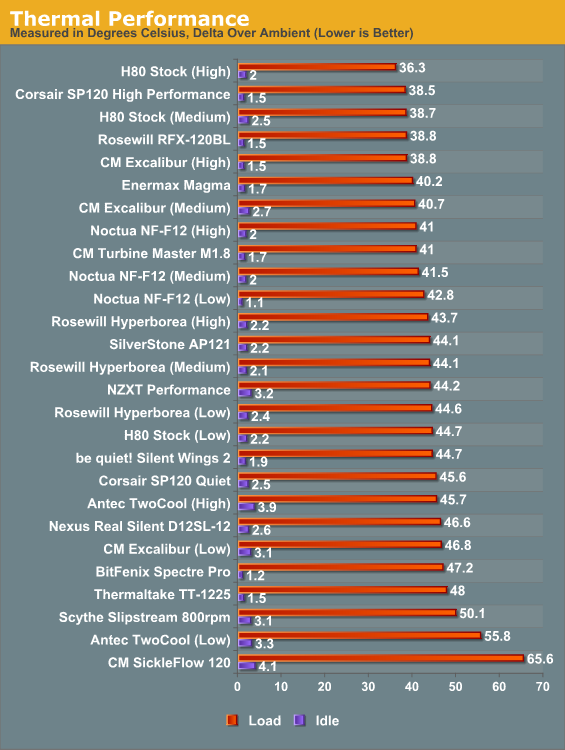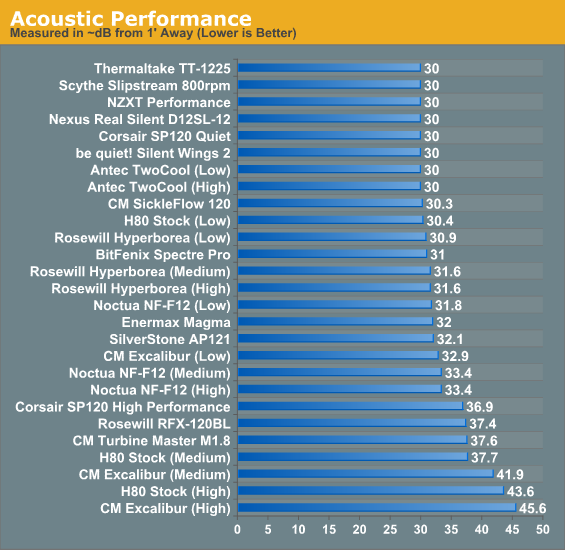120mm Radiator Fan Roundup Part 2: Fan Harder
by Dustin Sklavos on October 22, 2012 12:01 AM ESTTest Results
These are going to be...big charts. For comparison's sake I'm including a basic table first that has the stats for the previous fans I tested along with the ten new fans I tested in this roundup. That should give you a pretty solid refresher. Note that the PWM fans will be tested at the Corsair H80's low, medium, and high fan settings while the standard 3-pin voltage-driven fans are stuck at their highest setting. The exception is the Antec TwoCool 120 which has a built in speed switch that toggles between low and high speeds.
| Fan | Airflow (in CFM) | Static Pressure (in mm/H2O) | RPM | Rated dBA |
| H80 Stock | 46-92 | 1.6-7.7 | 1300-2500 | 22-39 |
| SP120 Quiet |
37.85 |
1.29 | 1450 | 23 |
| SP120 High Performance | 62.74 | 3.1 | 2350 | 35 |
| SilverStone AP121 | 35.36 | 1.71 | 1500 | 22.4 |
| BitFenix Spectre Pro | 56.22 | 1.24 | 1200 | 18.9 |
| Nexus Real Silent D12SL-12 | 36.87 | 1.2 | 1000 | 18 |
| CoolerMaster SickleFlow 120 | 69.69 | 2.94 | 2000 | 19 |
| NZXT Performance | 47.27 | 0.95 | 1300 | 25.35 |
| Enermax Magma | 69.15 | 1.4 | 1500 | 18 |
| CoolerMaster Excalibur | 26.4-85.6 | 0.75-3.53 | 600-2000 | 13-30 |
| CoolerMaster TM MACH 1.8 | 80.3 | 1.96 | 1800 | 30.5 |
| Noctua NF-F12 | 55 | 2.61 | 1500 | 22.4 |
| Scythe Slipstream | 40.17 | N/A | 800 | 10.7 |
| Thermaltake TT-1225 | 41.6 | N/A | 1400 | 21 |
| Antec TwoCool 120 | 21.3/42.6 | 0.24/0.96 | 600/1200 | 17/23.7 |
| Rosewill Hyperborea | 57.53 | 2.64 | 600-1300 | 6.9-16.05 |
| Rosewill RFX-120BL | 87.5 | N/A | 2200 | 38.15 |
| be quiet! Silent Wings 2 | 50.5 | 1.63 | 1500 | 15.7 |
As you can see, a lot of the vendors...like to flatter themselves. In fact, of the entire lineup only five are rated for noise above the noise floor of most commonly available consumer and even prosumer sound meters (that being 30dBA.) The best fan just from looking at the ratings would be the CoolerMaster SickleFlow 120 with its high static pressure, air flow, and low rated noise, but that fan turned out to be the worst fan in our last roundup by a long shot. Bottom line: don't believe everything you read on the packaging.
Ambient temperature during testing hovered between 23C and 25C. California has very strange weather. The margin for error on results is roughly 1C, and I'd strongly encourage you to mostly ignore the idle readings, which seem to show a little more variance and less reliability than the burned in load readings. I include them only for completeness' sake.

Corsair's solutions continue to be among the best performing if you're not at all concerned with noise. The H80's stock fan at its highest setting still remains essentially unstoppable and in fact offers excellent performance even at its medium setting. Interestingly, it turns out my wonderfully quiet Scythe Slipstream 800rpm fan barely moves any air; there are other fans that are nearly as quiet but produce substantially better thermal performance. Ultimately what we really need to beat is the H80 stock fan, though, and that seems to be easier said than done. Now let's see the noise levels under load.

As much as I'd like to say there's a pretty clear relationship between noise and thermal performance, there are still nuances to tease out. The CoolerMaster fans, for example, perform louder than the H80 stock fan while being less efficient.
There are a couple of data points I do want to tease out. First, the Enermax Magma is for the most part readily available in retail, reasonably priced, and may actually be the best balanced fan in the roundup. It lacks PWM control, but it offers performance near the top of the performance chart at only 32dB; that's about 5dB lower than all of the other fans above it. The Magma is popular on forums and with these results in hand it's easy to see why.
Out of the sub-31dB club, though, there's a surprise victory: the Rosewill Hyperborea PWM fan. The Hyperborea isn't really capable of producing much better performance at higher speeds, making its PWM capability mostly for show, but if you're looking for an aftermarket fan it's basically competitive with both the stock H80 fan and the NZXT Performance fan.
And what about the much ballyhooed Noctua? As it turns out, if you run the NF-F12 at a low speed it's able to produce nearly competitive performance with Enermax's option. The draw here is that the NF-F12 is much easier to get to run quieter and the character of its noise is actually less intrusive than many of the other fans; it's a fancier fan with more control, but you do pay handsomely for the privilege of owning one.
Past these notables, everything kind of blurs together.










81 Comments
View All Comments
xxtypersxx - Monday, October 22, 2012 - link
Add me to the list of users baffled by the omission of GentleTyphoon fans from the testing. This is like excluding a Jeep Wrangler from an off roader comparison.scook9 - Monday, October 22, 2012 - link
When I switched to water cooling, like any other good geek, I did an obsessive amount of research and reading online to find the best solution. Time and time again, I ended up with the same recommendation - the Scythe Gentle Typhoon 1850 rpm (AP-15) model. I have about 10 of these in my house now and use them on everything (HTPC, server, desktop, laptop cooler). They are expensive fans but they will also last a LONG time while performing very well.You may not need to do a 3rd roundup, just a 1 page one-off for this fan to satisfy the masses :D
Slyne - Monday, October 22, 2012 - link
Dustin,I can't be bothered to chek all the fans but, at least in the case of the Scyte Slipstream and Nexus RealSilent, those are case fans, not CPU fans. It's pointless to include them in this test.
And I second others in stating that if you're interested in sufficently powerful yet almost silent CPU fans, you may want to check the Gentle Typhoon and Noiseblocker.
khanov - Tuesday, October 23, 2012 - link
This exactly. After doing much research earlier this year I bought 2x gentle typhoon's and 2x Noiseblocker NB-Multiframe M12-P fans to add to my collection of Noctua's and other fans such as the excellent TR-TY140's.
After testing all of them the M12-P's stayed on my overclocked i7-3820 doing push/pull on a TRUE 120 heatsink. They are the business, quiet and powerful. Gentle typhoon's ran a close 2nd and are great fans also.
The fact that you don't include two of the best fans around for heatsink use seems odd to me. Looking forward to part 3 =)
BlueReason - Monday, October 22, 2012 - link
"Corsair's solutions"Really? It's a fan. Reconsider your use of the word "solution" as a replacement for everything. Sometimes it makes sense, but often it's just a silly fad word that has gotten out of control.
Streetwind - Tuesday, October 23, 2012 - link
hen you are writing a longer text, it is considered good form to occasionally replace often-repeating words with substitutions to improve the reading flow. If every sentence had the word "fan" in it, you'd eventually get dizzy. It's like starting every sentence in a story with "Then", that's just a no-go.Hulk - Monday, October 22, 2012 - link
I think it would be helpful to isolate fan performance.When reviewing cooling fans how about connecting each fan to be tested to a variable speed controller and set the speed of the fan to a predetermined cfm so that the fans can be evaluated on a level playing field. This way noise can be evaluated in an even playing field.
In the same manner speed can be increased/decreased to a predefined level and cfm and be measured.
Because in the end what we're really trying to determine is which fan moves the most air while being the most quiet while doing it.
Or, if you won't want to deal with cfm measurements, just load the test bed and increase/decrease the fan speed until the temperature is at a predetermined level. Then measure the noise.
JonnyDough - Monday, October 22, 2012 - link
No mention that CoolerMaster's Turbine is based on the compressor section of a turbofan jet engine? Hmm.nianiania - Monday, October 22, 2012 - link
You're testing the cooling capacity of fans for a radiator, in an environment this type of solution WILL NEVER BE USED IN. Broken right from the start. If someone's investing 60-120$ in a water cooler, the chances they're building an HTPC without a graphics card in the system are slim to none.This should have at least a 650 or 660 in the box to get a more real-world result. It's not often you let us down Anandtech, but this one is a pretty obvious failing on your part.
gcor - Monday, October 22, 2012 - link
I would quite like to know how many amps each of the fans actually draw, as it has been my experience that the spec sheets frequently list a value that is not accurate. In future reviews/round ups, would it be possible to measure and list the actual amps drawn please?